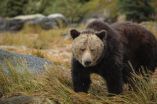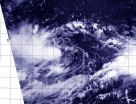(Press-News.org) EUGENE, Ore. -- Soil deep in a crater dating to some 3.7 billion years ago contains evidence that Mars was once much warmer and wetter, says University of Oregon geologist Gregory Retallack, based on images and data captured by the rover Curiosity.
NASA rovers have shown Martian landscapes littered with loose rocks from impacts or layered by catastrophic floods, rather than the smooth contours of soils that soften landscapes on Earth. However, recent images from Curiosity from the impact Gale Crater, Retallack said, reveal Earth-like soil profiles with cracked surfaces lined with sulfate, ellipsoidal hollows and concentrations of sulfate comparable with soils in Antarctic Dry Valleys and Chile's Atacama Desert.
His analyses appear in a paper placed online this week by the journal Geology in advance of print in the September issue. Retallack, the paper's lone author, studied mineral and chemical data published by researchers closely tied with the Curiosity mission. Retallack, professor of geological sciences and co-director of paleontology research at the UO Museum of Natural and Cultural History, is an internationally known expert on the recognition of paleosols -- ancient fossilized soils contained in rocks.
"The pictures were the first clue, but then all the data really nailed it," Retallack said. "The key to this discovery has been the superb chemical and mineral analytical capability of the Curiosity Rover, which is an order of magnitude improvement over earlier generations of rovers. The new data show clear chemical weathering trends, and clay accumulation at the expense of the mineral olivine, as expected in soils on Earth. Phosphorus depletion within the profiles is especially tantalizing, because it attributed to microbial activity on Earth."
The ancient soils, he said, do not prove that Mars once contained life, but they do add to growing evidence that an early wetter and warmer Mars was more habitable than the planet has been in the past 3 billion years.
Curiosity rover is now exploring topographically higher and geologically younger layers within the crater, where the soils appear less conducive to life. For a record of older life and soils on Mars, Retallack said, new missions will be needed to explore older and more clayey terrains.
Surface cracks in the deeply buried soils suggest typical soil clods. Vesicular hollows, or rounded holes, and sulfate concentrations, he said, are both features of desert soils on Earth.
"None of these features is seen in younger surface soils of Mars," Retallack said. "The exploration of Mars, like that of other planetary bodies, commonly turns up unexpected discoveries, but it is equally unexpected to discover such familiar ground."
The newly discovered soils provide more benign and habitable soil conditions than known before on Mars. Their dating to 3.7 billion years ago, he noted, puts them into a time of transition from "an early benign water cycle on Mars to the acidic and arid Mars of today." Life on Earth is believed to have emerged and began diversifying about 3.5 million years ago, but some scientists have theorized that potential evidence that might take life on Earth farther back was destroyed by plate tectonics, which did not occur on Mars.
In an email, Malcolm Walter of the Australian Centre for Astrobiology, who was not involved in the research, said the potential discovery of these fossilized soils in the Gale Crater dramatically increases the possibility that Mars has microbes. "There is a real possibility that there is or was life on Mars," he wrote.
Retallack noted that Steven Benner of the Westheimer Institute of Science and Technology in Florida has speculated that life is more likely to have originated on a soil planet like Mars than a water planet like Earth. In an email, Benner wrote that Retallack's paper "shows not only soils that might be direct products of an early Martian life, but also the wet-dry cycles that many models require for the emergence of life."
INFORMATION:
About the University of Oregon
The University of Oregon is among the 108 institutions chosen from 4,633 U.S. universities for top-tier designation of "Very High Research Activity" in the 2010 Carnegie Classification of Institutions of Higher Education. The UO also is one of two Pacific Northwest members of the Association of American Universities.
Source: Gregory J. Retallack, professor of geological sciences, 541-346-4558, gregr@uoregon.edu
Links:
VIDEO: Retallack discusses the findings: https://www.youtube.com/watch?v=vHglv8vSI-s&feature=youtu.be
Geology paper (link to abstract): http://geology.gsapubs.org/content/early/2014/07/14/G35912.1.abstract
Retallack faculty page: http://geology.uoregon.edu/profile/gregr/
Department of Geological Sciences: http://geology.uoregon.edu/
Museum of Natural and Cultural History: http://natural-history.uoregon.edu/
Follow UO Science on Facebook: http://www.facebook.com/UniversityOfOregonScience
UO Science on Twitter: http://twitter.com/UO_RIGE
More UO Science/Research News: http://uoresearch.uoregon.edu
Note: The University of Oregon is equipped with an on-campus television studio with a point-of-origin Vyvx connection, which provides broadcast-quality video to networks worldwide via fiber optic network. In addition, there is video access to satellite uplink, and audio access to an ISDN codec for broadcast-quality radio interviews.
Oregon geologist says Curiosity's images show Earth-like soils on Mars
Ancient fossilized soils potentially found in deep inside an impact crater suggest microbial life
2014-07-17
ELSE PRESS RELEASES FROM THIS DATE:
Is the universe a bubble? Let's check
2014-07-17
Never mind the big bang; in the beginning was the vacuum. The vacuum simmered with energy (variously called dark energy, vacuum energy, the inflation field, or the Higgs field). Like water in a pot, this high energy began to evaporate – bubbles formed.
Each bubble contained another vacuum, whose energy was lower, but still not nothing. This energy drove the bubbles to expand. Inevitably, some bubbles bumped into each other. It's possible some produced secondary bubbles. Maybe the bubbles were rare and far apart; maybe they were packed close as foam.
But here's the thing: ...
Orthopedic surgery generally safe for patients age 80 and older
2014-07-17
ROSEMONT, Ill.─Over the past decade, a greater number of patients, age 80 and older, are having elective orthopaedic surgery. A new study appearing in the Journal of Bone and Joint Surgery (JBJS) found that these surgeries are generally safe with mortality rates decreasing for total hip (THR) and total knee (TKR) replacement and spinal fusion surgeries, and complication rates decreasing for total knee replacement and spinal fusion in patients with few or no comorbidities (other conditions or diseases).
"Based on the results of this study, I think very elderly patients, ...
Study led by indigenous people uncovers grizzly bear 'highway'
2014-07-17
A novel, First Nations-led research collaboration has revealed a previously undocumented grizzly bear aggregation in coastal British Columbia, one of the most southerly aggregations of salmon-feeding grizzlies in North America. Using non-invasive DNA analysis, the authors describe a grizzly bear "highway," identifying nearly 60 individual bears, many who travelled hundreds of miles from surrounding areas to feed on autumn-spawning salmon in the Koeye River. The research was guided by the customary law and cultural practices of the Heiltsuk First Nation and recently published ...
Lipoic acid helps restore, synchronize the 'biological clock'
2014-07-17
CORVALLIS, Ore. – Researchers have discovered a possible explanation for the surprisingly large range of biological effects that are linked to a micronutrient called lipoic acid: It appears to reset and synchronize circadian rhythms, or the "biological clock" found in most life forms.
The ability of lipoic acid to help restore a more normal circadian rhythm to aging animals could explain its apparent value in so many important biological functions, ranging from stress resistance to cardiac function, hormonal balance, muscle performance, glucose metabolism and the aging ...
How the brain stabilizes its connections in order to learn better
2014-07-17
Throughout our lives, our brains adapt to what we learn and memorise. The brain is indeed made up of complex networks of neurons and synapses that are constantly re-configured. However, in order for learning to leave a trace, connections must be stabilized. A team at the University of Geneva (UNIGE) discovered a new cellular mechanism involved in the long-term stabilization of neuron connections, in which non-neuronal cells, called astrocytes, play a role unidentified until now. These results, published in Current Biology, will lead to a better understanding of neurodegenerative ...
NASA's Aqua satellite sees birth of Tropical Depression 10W
2014-07-17
The tenth tropical depression of the Northwestern Pacific Ocean was born as NASA's Aqua satellite passed overhead.
NASA's Aqua satellite passed over Tropical Depression 10W on July 17, as it came together northwest of the island of Yap. As Aqua passed overhead the Atmospheric Infrared Sounder (AIRS) instrument aboard captured infrared data that showed powerful thunderstorms developed around the storm's center. When AIRS gathered the data on the cloud tops, the temperatures were already as cold as -63F/-52C, indicating strong uplift has pushed them to the top of the troposphere.
At ...
NASA's TRMM satellite adds up Typhoon Rammasun's Philippines deluge
2014-07-17
Typhoon Rammasun dropped large amounts of rainfall over the Philippines, and the TRMM satellite was used to measure it from space. Rammasun is now making its way toward Hainan Island, China.
NASA and the Japanese Aerospace Exploration Agency partner on the Tropical Rainfall Measuring Mission or TRMM satellite. As TRMM orbits the Earth it has the ability to calculate rainfall occurring in storms and a rainfall analysis using TRMM and other data helps scientists calculate total rainfall.
A preliminary analysis of rainfall during the period when typhoon Rammasun was moving ...
Scientists track gene activity when honey bees do and don't eat honey
2014-07-17
CHAMPAIGN, Ill. — Many beekeepers feed their honey bees sucrose or high-fructose corn syrup when times are lean inside the hive. This practice has come under scrutiny, however, in response to colony collapse disorder, the massive -- and as yet not fully explained -- annual die-off of honey bees in the U.S. and Europe. Some suspect that inadequate nutrition plays a role in honey bee declines.
In a new study, described in Scientific Reports, researchers took a broad look at changes in gene activity in response to diet in the Western honey bee (Apis mellifera), and found ...
Measuring nurture: Study shows how 'good mothering' hardwires infant brain
2014-07-17
By carefully watching nearly a hundred hours of video showing mother rats protecting, warming, and feeding their young pups, and then matching up what they saw to real-time electrical readings from the pups' brains, researchers at NYU Langone Medical Center have found that the mother's presence and social interactions — her nurturing role — directly molds the early neural activity and growth of her offsprings' brain.
Reporting in the July 21 edition of the journal Current Biology, the NYU Langone team showed that the mother's presence in the nest regulated and controlled ...
Scripps Florida scientists identify gene that plays a surprising role in combating aging
2014-07-17
JUPITER, FL, July 17, 2014 – It is something of an eternal question: Can we slow or even reverse the aging process? Even though genetic manipulations can, in fact, alter some cellular dynamics, little is known about the mechanisms of the aging process in living organisms.
Now scientists from the Florida campus of The Scripps Research Institute (TSRI) have found in animal models that a single gene plays a surprising role in aging that can be detected early on in development, a discovery that could point toward the possibility of one day using therapeutics, even some commonly ...
LAST 30 PRESS RELEASES:
Decoupling the HOR enhancement on PtRu: Dynamically matching interfacial water to reaction coordinates
Sulfur isn’t poisonous when it synergistically acts with phosphine in olefins hydroformylation
URI researchers uncover molecular mechanisms behind speciation in corals
Chitin based carbon aerogel offers a cleaner way to store thermal energy
Tracing hidden sources of nitrate pollution in rapidly changing rural urban landscapes
Viruses on plastic pollution may quietly accelerate the spread of antibiotic resistance
Three UH Rainbow Babies & Children’s faculty elected to prestigious American Pediatric Society
Tunnel resilience models unveiled to aid post-earthquake recovery
Satellite communication systems: the future of 5G/6G connectivity
Space computing power networks: a new frontier for satellite technologies
Experiments advance potential of protein that makes hydrogen sulfide as a therapeutic target for Alzheimer’s disease
Examining private equity’s role in fertility care
Current Molecular Pharmacology achieves a landmark: real-time CiteScore advances to 7.2
Skeletal muscle epigenetic clocks developed using postmortem tissue from an Asian population
Estimating unemployment rates with social media data
Climate policies can backfire by eroding “green” values, study finds
Too much screen time too soon? A*STAR study links infant screen exposure to brain changes and teen anxiety
Global psychiatry mourns Professor Dan Stein, visionary who transformed mental health science across Africa and beyond
KIST develops eco-friendly palladium recovery technology to safeguard resource security
Statins significantly reduce mortality risk for adults with diabetes, regardless of cardiovascular risk
Brain immune cells may drive more damage in females than males with Alzheimer’s
Evidence-based recommendations empower clinicians to manage epilepsy in pregnancy
Fungus turns bark beetles’ defenses against them
There are new antivirals being tested for herpesviruses. Scientists now know how they work
CDI scientist, colleagues author review of global burden of fungus Candida auris
How does stroke influence speech comprehension?
B cells transiently unlock their plasticity, risking lymphoma development
Advanced AI dodel predicts spoken language outcomes in deaf children after cochlear implants
Multimodal imaging-based cerebral blood flow prediction model development in simulated microgravity
Accelerated streaming subgraph matching framework is faster, more robust, and scalable
[Press-News.org] Oregon geologist says Curiosity's images show Earth-like soils on MarsAncient fossilized soils potentially found in deep inside an impact crater suggest microbial life






